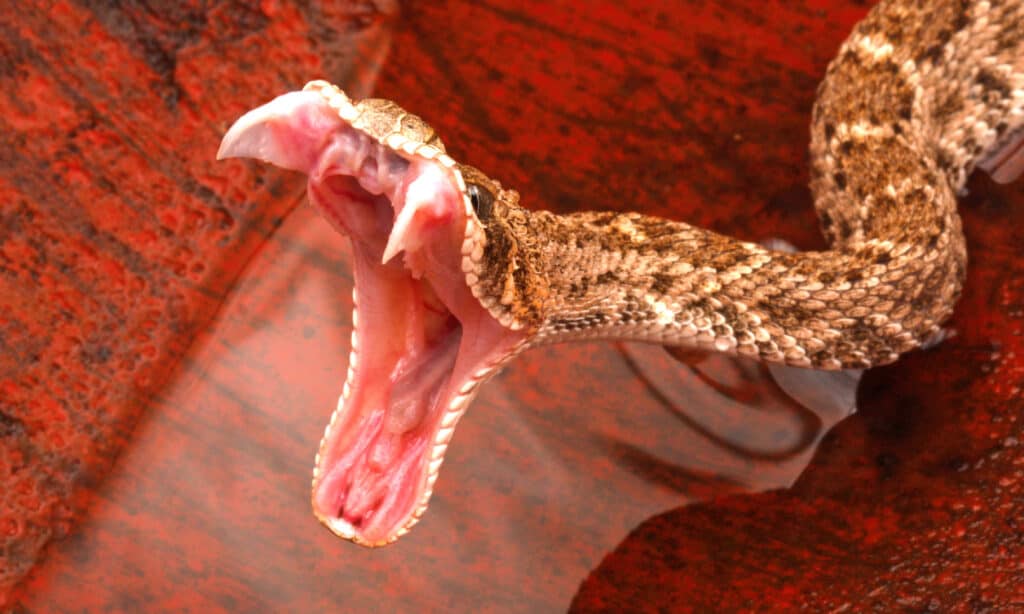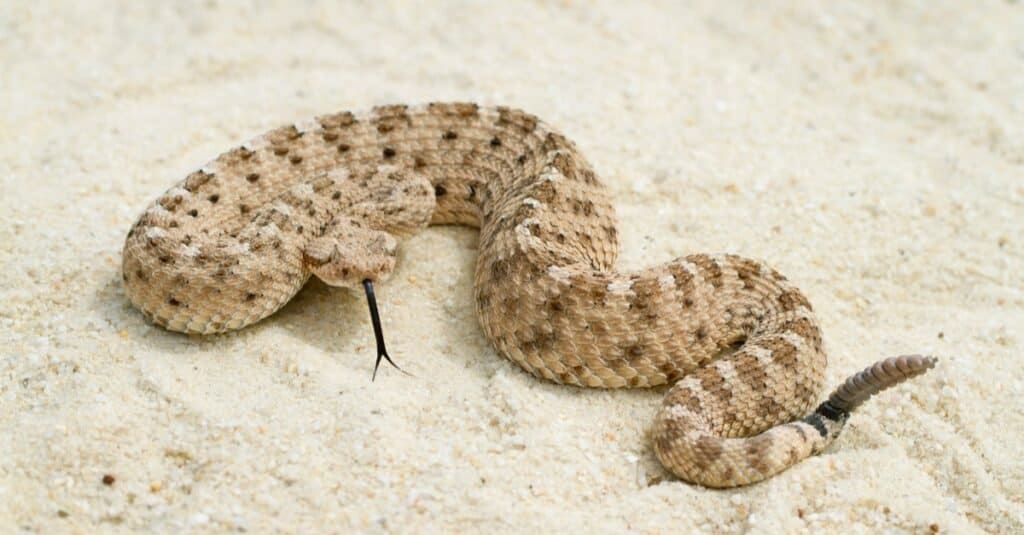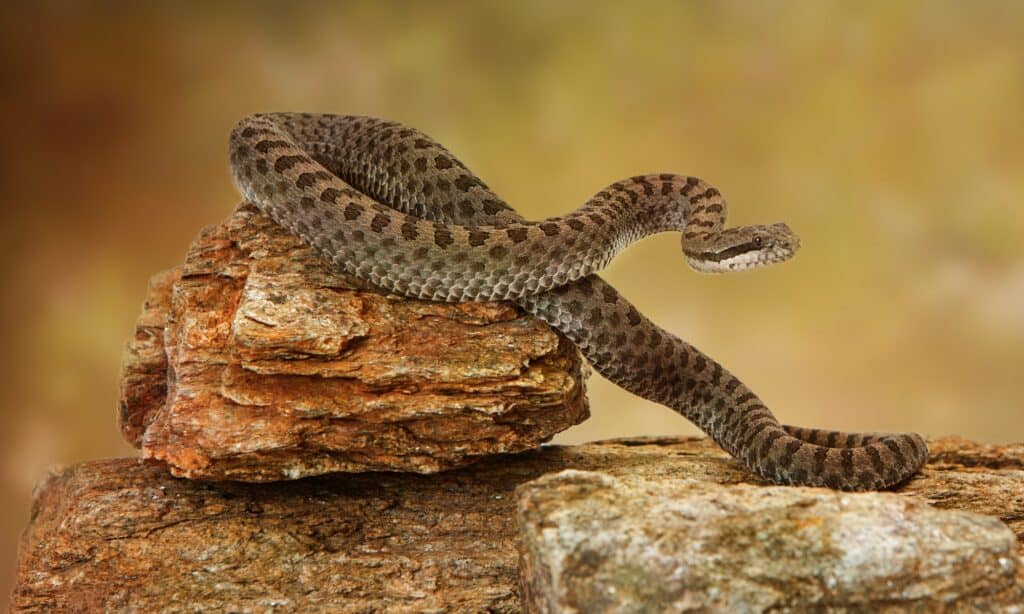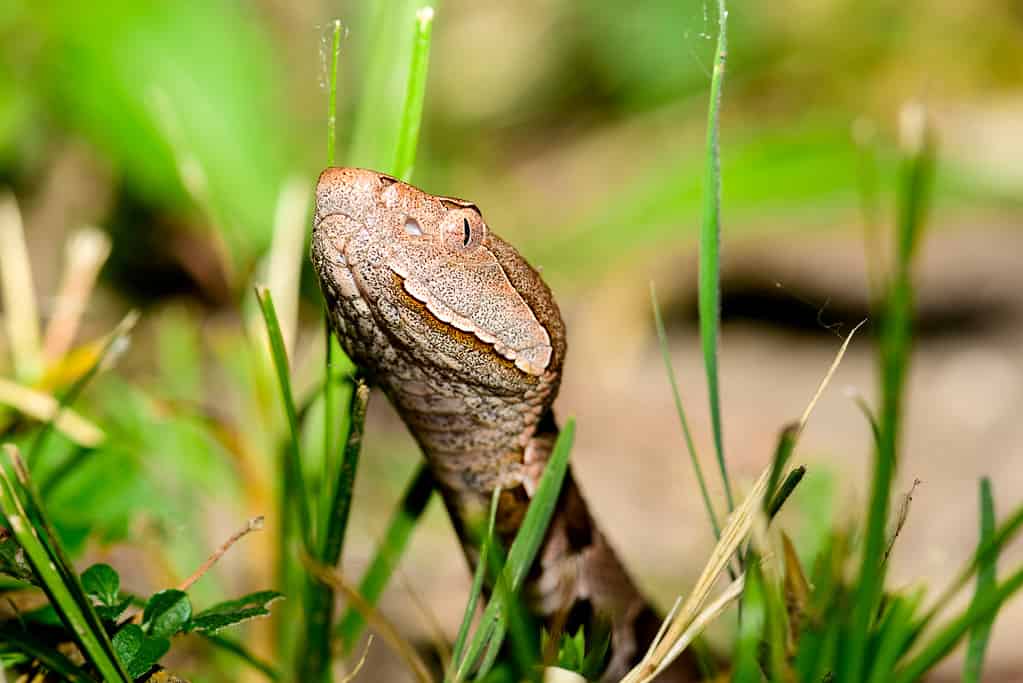While Alabama might not be very close in proximity to Arizona, both of these states have some pretty surprising venomous snake species. In this guide, we’ll take a look at all of the venomous snakes both states have to offer! We’ll also break down Arizona vs. Alabama venomous snakes to see which state has more venomous species.
Arizona vs. Alabama Venomous Snakes: Venomous Snakes in Arizona
1. Mojave Rattlesnake
AKA: Crotalus scutulatus
The dangerous Mojave Rattlesnake lives in the desert regions of Arizona. Their venom contains a neurotoxin as well as a hemotoxin. Their venom has the potential to cause respiratory failure, terrible pain, swelling, tissue damage, and even death in severe cases.
Despite being extremely rare in Arizona, bites from these snakes are particularly dangerous due to the potency of their venom. It’s critical to exercise care and get aid immediately if you are bitten. The Mojave Rattlesnake may be recognized by its eye-catching tail banding of black and white.
2. Black-Tailed Rattlesnake
AKA: Crotalus molossus
The venomous Black-Tailed Rattlesnake can be found in Arizona’s mountainous regions. Its venom is often milder than other rattlesnake species’ venom. However, it can still cause significant pain, edema, and overall skin and muscle damage if left untreated. Bites from these snakes are not very common in Arizona since they are normally not aggressive or even defensive toward people and seek to avoid altercations with potential predators.
However, it is always advisable to use caution while approaching any snake in the wild, and if bitten, you should seek medical attention straight once. Due to its distinctive pattern and black tail, the Black-tailed Rattlesnake can be differentiated from other rattlesnake species.
3. Western Diamondback Rattlesnake
AKA: Crotalus atrox
When it comes to Arizona vs. Alabama venomous snakes, this snake has a pretty similar cousin species from Alabama that we will describe later on in this guide. The Western Diamondback Rattlesnake, one of Arizona’s most venomous snakes, is widespread throughout the state’s desert regions. Its venom may be extremely toxic and cause agonizing pain, edema, tissue damage, and even death if untreated.
Bites from these snakes are rather common in Arizona, particularly during the warmer months when they are most active. It is vital for residents and tourists to be aware of the hazards presented by these snakes and to take the necessary measures while spending time outside in rattlesnake habitat.

©iStock.com/johnaudrey
4. Western Massasauga
AKA: Sistrurus tergeminus
The Western Massasauga is a small but still very much venomous snake that lives in grassland and riparian areas of Arizona. In general, its venom is weaker than that of other venomous species in the state. However, it can still cause significant pain, edema, and tissue damage if not properly treated.
Bites from these snakes are quite uncommon in Arizona since they are normally cautious and non-aggressive toward humans. Due to its small stature and distinctive facial traits, the Western Massasauga can be easily identified for herpers who want to find them and hikers who want to avoid them. These snakes can be distinguished from rattlesnakes in Arizona’s desert quite easily.
5. Western Rattlesnake
AKA: Crotalus oreganus
The Western Rattlesnake is a venomous species that lives in many habitats throughout Arizona. Its venom may be extremely toxic and can cause unbearable pain, edema, tissue damage, and even death if not properly treated. Bites from Western Rattlesnakes are unfortunately rather common in Arizona, particularly during the warmer months when they are most active.
It is vital for residents and tourists to be aware of the hazards presented by these snakes and to take the necessary measures while spending time outside in rattlesnake habitat. The Western Rattlesnake’s dark and grey color helps it blend in with its surroundings. Due to this, it may be challenging to see these snakes when hiking. Anywhere in the state you go trekking, always be careful to keep your eyes on your feet when moving.
6. Arizona Coral Snake
AKA: Micruroides euryxanthus
The Arizona Coral Snake is a venomous species of snake found in the southeast of Arizona. If left untreated, its neurotoxic venom can cause respiratory failure as it targets the nervous system. Although Arizona doesn’t see many of these snake bites, they can be lethal if left untreated.
The coral snake is simple to identify thanks to its distinctive red, yellow, and black striped pattern. If a coral snake or other dangerous animal bites a person, they should be aware of them and seek medical attention straight once.
7. Rock Rattlesnake
AKA: Crotalus lepidus
Arizona’s rocky landscape is home to a significant population of rock rattlesnakes. The Rock Rattlesnake’s camouflage color helps it blend in with its rocky surroundings. Its venom is often milder than other rattlesnake species’ venom. However, it can still cause significant pain, edema, and tissue damage if left untreated.
Rock Rattlesnake bites are uncommon in Arizona since they are normally not hostile toward people and seek to avoid combat. However, it is always advisable to use caution while approaching any snake in the wild, and if bitten, you should seek medical attention straight once.
8. Arizona Black Rattlesnake
AKA: Crotalus cerberus
The dangerous Arizona Black Rattlesnake lives in the desert and valleys of Arizona. They have distinct crossbands of greyish-white and a black hue all over their body. Their venom is extremely lethal, and in dire circumstances, going untreated for a bite can be fatal. Fortunately, attacks from these kinds of snakes are uncommon in Arizona. These snakes are also widely recognized for rattling loudly and constantly when startled. If you’re too close, you’ll likely hear them before they strike.
9. Sidewinder
AKA: Crotalus cerastes
When it comes to Arizona vs. Alabama venomous snakes, the Sidewinder is a major competitor. The venomous Sidewinder, commonly known as the Horned Rattlesnake, is found in Arizona’s desert regions. In addition to having protrusions that resemble horns above their eyes, they have a particular adaptation that enables them to travel sideways while leaving distinct “footprints” in the sand.
Healthy individuals are often not in danger of major injury from this snake’s venom, despite the fact that it can cause pain, swelling, and tissue damage and is mildly venomous. Bites from Sidewinders are quite uncommon in Arizona.
The Sidewinder has an odd behavior since it spends most of the day buried in the sand to escape the heat and is primarily nocturnal. Care should always be taken while interacting with any snake in the wild, despite the fact that their sideways mobility and horn-like protrusions make them an intriguing species to examine. They’re cool to look at, but do not touch!

©Mark_Kostich/Shutterstock.com
10. Ridge-Nosed Rattlesnake
AKA: Crotalus willardi
The venomous Ridge-Nosed Rattlesnake lives in the desert regions of Arizona. Their name derives from a distinctive ridge-like scale that covers their nose. They are normally tan or brown in appearance with darker crossbands. Their venom is potent and, in dire situations, can cause respiratory collapse and death. Additionally, their venom may result in extreme discomfort, edema, and tissue damage.
The Ridge-Nosed Rattlesnake is well known for its peculiar mating behavior, in which the males compete for the ladies’ attention by engaging in a fighting dance. These snakes usually avoid biting and are not hostile toward humans.
11. Tiger Rattlesnake
AKA: Crotalus tigris
The dangerous Tiger Rattlesnake, also known as the Arizona Desert Massasauga, is found in the desert regions of Arizona. They have a bright golden or orange tint with dark bands or stripes that mimic tiger stripes as their distinguishing color.
This species’ venom is extremely venomous. In extreme cases, it can cause tissue destruction and respiratory failure. Arizona is a fairly unusual place for them to bite. The Tiger Rattlesnake normally behaves calmly, but if required, they will defend themselves. It is important for residents and tourists to be aware of locations where the Tiger Rattlesnake resides when spending time outside in any rattlesnake habitat.
12. Speckled Rattlesnake
AKA: Crotalus mitchellii
The dangerous Speckled Rattlesnake lives in the rugged and dry areas of Arizona. They are also common in New Mexico and Texas. Their venom contains both a hemotoxin and a neurotoxin, which in severe cases can cause respiratory failure, discomfort, swelling, tissue damage, and even death if left untreated.
Bites from these snakes are pretty uncommon in Arizona since they are normally not hostile toward people and seek to avoid fights or danger in general. The Speckled Rattlesnake is quite simple to detect when out trekking due to its remarkable speckled coloration and small size.
13. Twin-Spotted Rattlesnake
AKA: Crotalus pricei
The dangerous Twin-Spotted Rattlesnake lives in Arizona’s drier, more arid areas. They have two large spots on their head and a series of black blotches all over their body. Their color might be light brown, dark gray, or a copper brown. This animal’s venom is extremely lethal, and in dire circumstances, it can cause excruciating agony and even death. These snake bites are not particularly common in Arizona, though.
The Twin-Spotted Rattlesnake is well known for its unique defense mechanism, which involves flattening its body and quickly shaking its tail to generate a buzzing sound resembling a baby rattle. This can deceive and frighten off predators. This rattle can be useful while spending time outside in areas where rattlesnakes are common for the protection of both the snake and nearby humans.

©iStock.com/adogslifephoto
14. Hopi Rattlesnake
AKA: Crotalus viridis nuntius
The dangerous Hopi Rattlesnake may be found in the canyons and rocky parts of Arizona. Compared to other rattlesnake species, its venom is generally mild. In the wild, the Hopi Rattlesnake can be recognized by its unusual coloring, which includes black and white striping and a red-orange tail.
Arizona vs. Alabama Venomous Snakes: Venomous Snakes in Alabama
1. Eastern Diamondback Rattlesnake
AKA: Crotalus adamanteus
The stunning but very venomous snake species known as the Eastern Diamondback Rattlesnake may be found in southern Alabama. The most venomous snake in North America, it is feared for its size and is distinguished by the peculiar diamond-shaped markings running along its back.
This species deserves respect with an average length of four to five feet and some reaching up to eight feet. Although deadly, bites from Eastern Diamondback Rattlesnakes are not common in Alabama. They normally prefer to stay away from people and only attack when provoked or threatened. To maintain personal safety, it is vital to take precautions and keep a safe distance from them in their natural environment.
2. Eastern Coral Snake
AKA: Micrurus fulvius
Southern Alabama is home to the venomous Eastern Coral Snake, a type of snake with vivid colors. It has a stunning look due to the unique red, yellow, and black stripes that run over its body. The Eastern Coral Snake is tiny, usually measuring approximately two feet in length, yet its venom is very toxic. However, this snake doesn’t typically attack people in Alabama. They are quiet and withdrawn people who would rather avoid conflict than engage in it. To reduce the danger of bites, always keep your eyes on your feet when hiking in snake territory in Alabama!
3. Timber Rattlesnake
AKA: Crotalus horridus
Alabama is home to another venomous snake species known as the Timber Rattlesnake. It attracts the eye with its powerful physique and unique black patterns on a light brown backdrop. It may reach a length of four to five feet and is recognized for its rattling tail, which it uses as a warning signal when in danger.
Despite the possibility of Timber Rattlesnake bites in Alabama, actual interactions with them are rather uncommon because of their solitary nature. They would sooner flee from people than face them. However, keep a safe distance if you come across one in its native environment.
4. Copperhead
AKA: Agkistrodon contortrix
The Copperhead is a venomous snake species commonly found throughout Alabama. It possesses a distinct copper-colored head and a pattern of hourglass-shaped bands on its body. Growing up to two to three feet in length, it is considered a medium-sized venomous snake.
Copperhead bites are relatively common in Alabama due to their presence in a variety of habitats shared with humans, including forests, swamps, and residential areas. However, while their venom can cause discomfort and pain, fatalities from Copperhead bites are rare. This is because the Copperhead’s venom is generally not as potent as that of some other venomous snake species. Nonetheless, it is crucial to exercise caution and avoid provoking or handling Copperhead snakes to minimize the risk of bites and potential complications.

©iStock.com/JWJarrett
5. Pygmy Rattlesnake
AKA: Sistrurus miliarius
The venomous Pygmy Rattlesnake can be found in a variety of settings throughout Alabama. Despite being little (usually between one and two feet long), a bite from this snake should not be taken lightly. This snake blends in nicely with its environment thanks to its body’s gray or tan color and black patches or blotches. Although Pygmy Rattlesnake bites can happen in Alabama, they are not very often reported. These snakes are typically non-aggressive and would rather flee from humans than engage with them.
6. Cottonmouth
AKA: Agkistrodon piscivorus
Alabama is home to the venomous Cottonmouth snake, often known as the Water Moccasin. It is most frequently found in wetlands and close to water. It derives its name from the white, cotton-like lining that it exhibits in its mouth. This snake, which may reach lengths of four to five feet, has a thick body and a unique black coloring. Cottonmouth snake bites are possible in Alabama, but they are not common. Although normally peaceful, these snakes can become hostile if challenged or trapped.
Summary of Venomous Snakes in Arizona and California
When it comes to Arizona vs. Alabama venomous snakes, it looks like Arizona comes out on top!
The post Arizona vs. Alabama: Which State Has More Venomous Snakes? appeared first on AZ Animals.
from Animal News, Facts, Rankings, and More! - AZ Animals https://ift.tt/Z1TOFpt